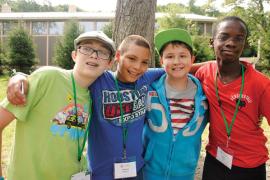In a world that is witnessing the most dramatic demographic transformation in its history, these words could not be more poignant. Defining camp by duration, activity, or location, or by labels such as resident, day, for profit, or nonprofit, has become a secondary issue to those who are deciding whether to send a young person to camp or not.
We used to say to ourselves: “If we just launched a stronger public relations campaign, we would have greater influence on a family’s decision making about the camp experience.” Today, I wish it were that simple. Family dynamics alone complicate that formula. Or, consider the fact that as long as ACA stays at only 25 percent of the larger, more diverse camp marketplace, our influence will remain difficult to achieve in such an increasingly competitive space.
The good news is that as a community that has had to adapt and evolve for over 100 years, we, too, have been learning for life. Today, as we have for over 100 years, camps all across the country are developing new strategies to meet the demands and needs of the new and revolutionized marketplace. Take, for example, just a few of the many camps featured in Camping Magazine’s 20/20 Toolbox Series: Camp Izza, the first ACA-accredited Muslim day camp; Camp Butterfly, which teaches girls and women of African descent about themselves and the natural world; or Tim Horton Camp Kentahten, which partners with communities and like-minded organizations to provide camp scholarships to economically disadvantaged children. (View all 20/20 Toolbox articles at www.ACAcamps.org/campmag/2020-toolbox.)
The ACA camp community is reaching out to new partners, technologies, and networks, and, subsequently, learning about market expectations, needs, and wants. We are hearing that people (youth) want interactive, immersive, and participatory activities that prepare them for life in the twenty-first century. We are no longer trying to sell who we are but rather what we do to make a difference in one’s life and career — and how we do it.
It is not about a summer learning gap but access to quality, intentional, experiential learning opportunities for all children and youth. Jacki Breger, who has been an ACA member for more than forty years, appropriately describes it as an “experience gap.” It is not about a place — or spending more time in that place — but the essence of the experience. As Ed Greene, an ACA national board member said in 2010: “It is about an experience that understands that humanity demands diversity of thought and creating more ways of thinking, living, and being.”
Camp is an experience that strengthens one’s life journey; it enables, reinforces, and facilitates one’s ability to learn for life. It is a process of risks and mistakes that are meaningful and reflective — not a series of grades, scores, and tests. It is not about the right or wrong answer but the critical-thinking process that reveals patterns and alternatives. Camp is about taking experiences and adding language that not only expands understanding of self but of others.
Experiences and language work together to shape memories, thoughts, and knowledge. As quoted in Ellen Galinsky’s Mind in the Making, Alison Gopnik, a professor of psychology at University of California, Berkeley, says: “If we want to be successful and deal with other people, [we need] to understand the people around us — particularly what’s going on in their minds” (2010).
So we must ask ourselves: “What is going on in the minds of children and youth at camp?”
It is said that critical thinking is a higher-order skill among executive functions of the brain. When young people at camp learn to step back and look at what they are doing, reflect on the task or problem, evaluate it, and consider alternative solutions, they are learning for life.
Young people are compelled by a thirst to know and understand — curiosity. When young people at camp have an opportunity to explore, expand, and master a new skill or knowledge, they are experiencing the power of persistence. They are learning for life.
When you place challenges before young people in safe environments, they are ready to learn. The structure and routine of camp fosters learning. In such an environment, one that affords and encourages self-directed activities that fully engage the participants, they are learning for life.
Finally, it has been said that you cannot place young people in a cognitive bubble. In a camp experience, caring profession¬als encourage children’s emotional and social well-being — two critical and valued components of learning for life.
When you visit a quality camp experience, you will not find dullness in the eyes of the participants or silenced voices — but a spark, an ignition. They are learning for life.
References
Galinsky, E. (2010). Mind in the making. New York, NY: William Morrow Paperbacks.
ACA. (2010). The future is now: A conversation with Fred Miller. Camping Magazine, 83(1).
With nearly three decades of experience as a change agent in youth development and transformation, Peg L. Smith is the chief executive officer of ACA. ACA is the champion of better tomorrows — providing resources, research, and support for developmentally appropriate camp experiences. Learn more at www.CampParents.org or www.ACAcamps.org.
Originally published in the 2013 January/February Camping Magazine



